EASTHAM — It’s an almost-balmy Monday in March, the kind of day that signals the end of sweater weather is nigh, but the students at the Yarn Club meeting at Nauset Regional High School are focused on all things cozy — hooking, knitting, and stitching, just as they have every Monday afternoon since the group got underway in January.
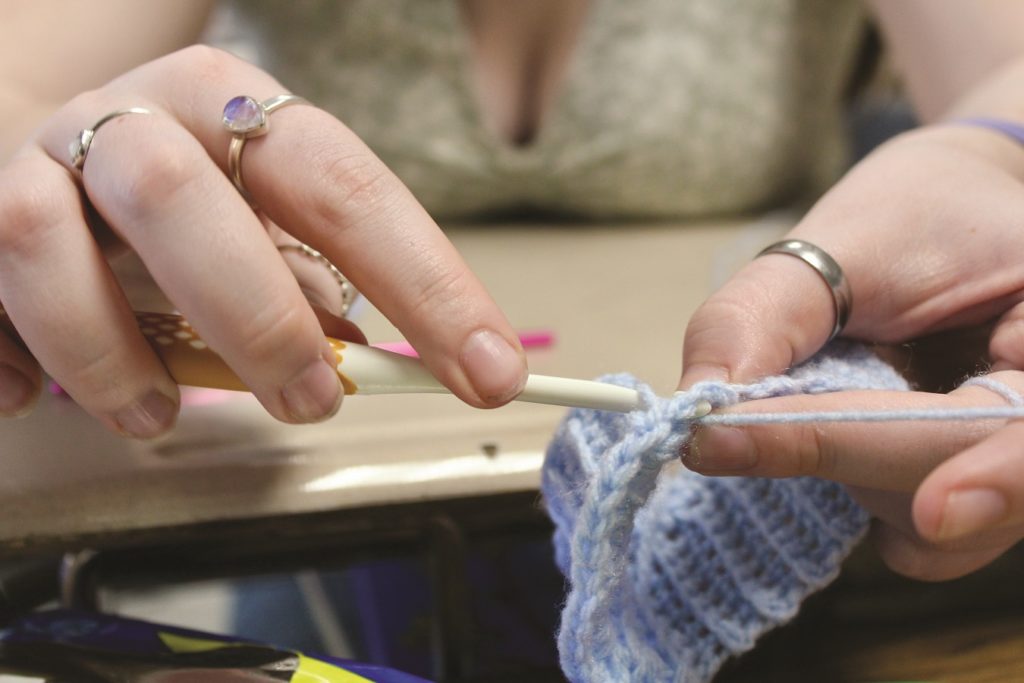
Isabel Stuehmer, a sophomore from Brewster, is making a baby-blue sweater she’ll wear playing a dad in Nauset’s production of The Yellow Boat. She’s working a stitch called the half double crochet. Using a hook, crocheters pull loose yarn through three loops rather than the usual two. This makes for a denser fabric, well-suited to keeping out the cold.
Michael Terrenzi is working on his moss stitch. Chunky knitting needles in hand, the senior from Eastham explains that, to execute this technique, a cousin of the seed stitch, knitters alternate knit and purl stitches. Both are fundamental to most knitting patterns.
Terrenzi learned this when he joined the club shortly after it formed in January. As he starts his senior spring, he likes to pair the methodical practice of knitting with watching TV. “Like a little grandma,” he says, “I knit and watch Jeopardy.”
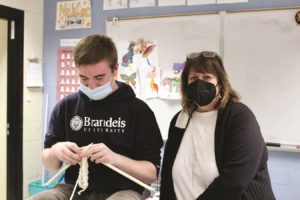
The idea of starting a club for yarnies came to French teacher Ellen Dill and several students during an outdoor mask break in the fall. Dill, who advises the club, noticed a student wearing something handmade, and talk turned to knitting and crocheting.
Vayda Smith, a junior from Brewster, followed up on the conversation and worked with Dill to get the Yarn Club off the ground.
Six students came to the club’s first meeting. Nine came the next week, and 30 the week after that. Dill sent an email to other faculty members with the subject “Got Yarn?” Many responded to her call for supplies. Now, bags and baskets filled with yarn line the wall under Dill’s whiteboard.
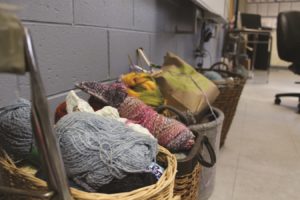
Almost all of the desks in Dill’s classroom are occupied as Terrenzi tackles the moss stitch.
A web of colorful crocheted flowers spreads across the desk where Smith, who uses the pronoun “they,” sits and stitches. It’s part of a project with an intricate design and sophisticated palette that make it hard to believe they learned to crochet only at the beginning of this school year.
Seven months into practicing the craft, Smith has several WIPs (works-in-progress) besides the web of flowers. They’re currently making a sweater to match the diamond-patterned coat that often appears draped around the shoulders of Howl, a fictional wizard who inhabits the enchanted castle in Howl’s Moving Castle, the Japanese fantasy film animated by Studio Ghibli.
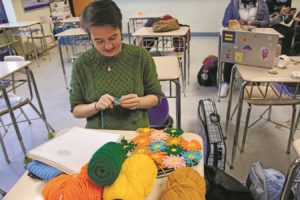
Stuehmer’s WIPs include several blankets measuring roughly 60 by 70 inches. Her thick, fuzzy blankets were wildly popular with family members, so she decided to advertise them on her Instagram account. She received 20 orders in January alone.
Like Terrenzi, Smith and Stuehmer like to keep their hands busy when focusing on other tasks. “I crochet all the time in class,” Smith says. That’s how the web of flowers grew.
Smith has long used art as a tool for focusing. “When I was in elementary school, I had to get a permission slip to doodle in class because I would not be able to sit still otherwise,” they explain.
Smith isn’t alone in this. Dill says many other students leave projects in her classroom and come get them to work on during classes where teachers allow them to knit.
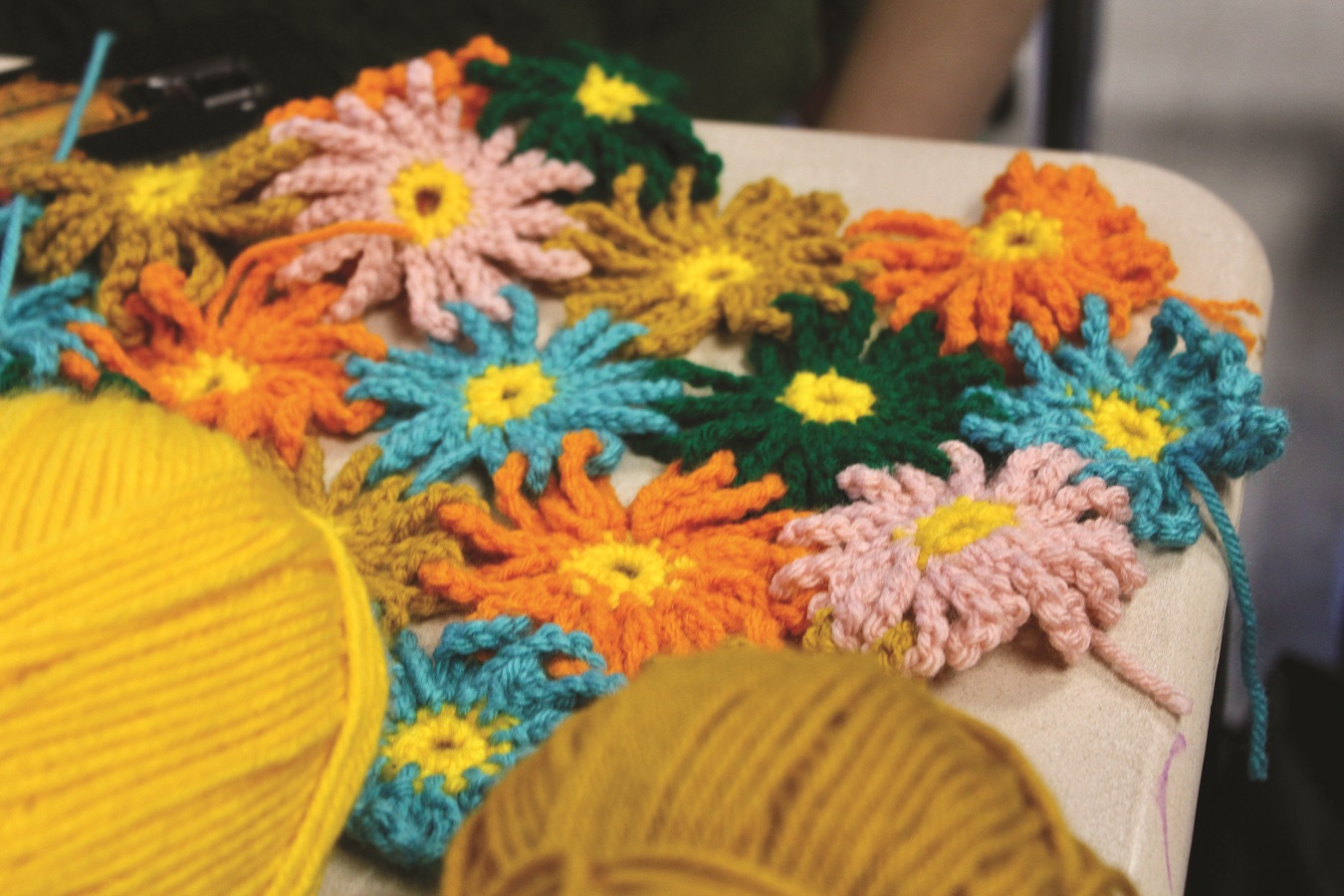
Dill used to do the same as a student. For a psychology class at Mount Holyoke College, she explored knitting as behavior management — she knitted to make Christmas presents and as a way to reduce undesirable behaviors. Lectures seemed the perfect place to make headway on her projects, she said.
Dill decided to track her school performance throughout the experiment. Sure enough, her grades improved when she was busy with her hands, which she says helped her listen and participate in conversation.
Today, Dill says, “students are really disrupted by social media.” In classrooms where students need to use technology, notifications from Instagram or TikTok constantly interfere with attention. She finds that allowing students to knit during oral exercises and discussions in her French classes improves their engagement.
It’s not all about improving the academic experience, though. Terrenzi, who’s bound for Brandeis University in the fall, packed his final high school years with extracurriculars such as Key Club, of which he was president, and volleyball. For him, Yarn Club is a refuge from the pressure to achieve.
“I’m not the president,” he says. “I don’t have to worry about any of it.”



